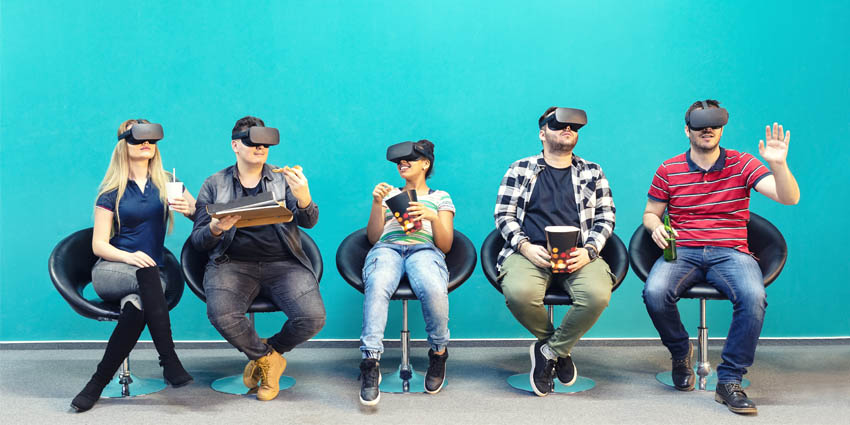In 2024, VR headset trends aren’t just impacting consumers; they’re also helping to shape the future of immersive work and the enterprise metaverse. In recent years, virtual reality has proven to be a valuable tool for companies in all industries.
Cutting-edge headsets are redefining collaboration in the age of remote and hybrid work, opening the door to faster product development and even transforming customer service. By 2032, experts predict the market for VR headsets will be worth an incredible $142.5 billion, and countless companies are discovering the benefits of the immersive revolution.
Whether you’re planning on investing in VR headsets for the first time in 2024 or taking the next step in your immersive journey, it’s worth keeping up with the trends. Here are some of the biggest VR headset trends we think will transform the industry in 2024.
1. Enterprise Adoption Shapes VR Headset Trends
Initially, many VR headset vendors focused on creating products targeted exclusively at consumers. Some of the earliest devices were specifically created for gaming and entertainment. However, the demand for enterprise-level headsets has increased in recent years.
Innovations in the “industrial metaverse” and the demand for enhanced training opportunities have highlighted an incredible chance for enterprise VR. Many major vendors are beginning to recognize this trend, adapting their headsets to suit business needs.
Meta introduced a new “Meta Business” service for enterprise customers. Apple began building the Apple Vision Pro with a focus on enterprise needs. Countless other vendors have even designed headsets to be more robust for industrial environments. On a broader scale, many VR vendors are investing in more advanced displays, more lightweight headsets, and improved ergonomics to counteract the issue of VR sickness for business users.
2. Spatial Computing Reduces Reliance on Controllers
In the past, most virtual reality headsets came packaged with controllers designed to help users interact easily with digital content. Today, these controllers are becoming more sleek, ergonomic, and user-friendly. However, many users still feel controllers detract from their immersive experiences.
To create more natural experiences in the virtual world, headset vendors are beginning to experiment with spatial computing technology. Spatial technologies like eye tracking, hand-tracking tools, sensors, and voice controls are becoming popular VR headset trends.
With these innovative solutions, vendors can allow users to interact with virtual applications and software more naturally, using their eyes, voice, and gestures. Some spatial solutions can even improve VR headset performance. For instance, eye tracking solutions allow for foveated rendering, which enables the headset to dynamically adjust the display based on what a user looks at.
3. Multi-Sensory Virtual Reality
Demand for hyper-realistic and immersive experiences drives new virtual reality headset trends. During the initial years of the VR revolution, the level of immersion a headset offered depended mainly on its display quality and visuals. Now, companies are investing in new ways to involve additional senses in the VR experience.
Haptic gloves and suits are beginning to experience a resurgence in popularity, particularly in the VR training landscape. These haptic tools are ideal for enhancing realism and building muscle memory. Elsewhere, companies are beginning to experiment with other sensory solutions.
VR headset accessories like masks can bring unique smells to an environment to deepen immersion. Spatial audio solutions can make the sound more organic and natural when moving around a virtual landscape. There are even VR treadmills available that can be accompanied by fans and similar tools to create atmospheric sensations.
4. AR, VR and MR Convergence
Virtual, augmented, and mixed reality are all distinct technologies with unique benefits in various use cases. However, as companies continue to embrace the benefits of immersive experiences, many are reluctant to invest in separate devices for different levels of immersion.
This has led to one of the most interesting VR headset trends in recent years, the convergence of different extended reality experiences. Companies like Meta have introduced new mixed reality capabilities into their latest virtual reality headsets, allowing users to control their level of immersion. Innovators like Apple are taking a similar approach with the Apple Vision Pro.
In the years ahead, we may see more companies investing in the potential of AR/VR headsets, and virtual reality solutions with mixed reality capabilities. This will allow businesses to explore all the different flavors of extended reality.
5. AI Innovations in Virtual Reality
The rise of artificial intelligence in extended reality isn’t one of the newest virtual reality headset trends. For years, innovators in the VR landscape have used AI in their headsets to enhance immersive experiences. Intelligent algorithms in headsets can allow users to control experiences using their own voice and natural language processing.
AI tools can also help analyze the surrounding environment of a VR headset user, helping keep headset wearers safe as they navigate digital landscapes. AI can even analyze user behavior during immersive experiences and adapt the landscape to each person’s needs.
However, the rise of more advanced forms of AI is opening the door to an even stronger relationship between AI and VR. Generative AI paves the way for advanced headset development strategies, helping companies create more amazing avatars and VR scenery. Companies like Nvidia are even using generative AI to assist companies in creating powerful metaverse experiences.
The VR Headset Trends Worth Watching This Year
VR headset trends are evolving at an incredible rate as demand for immersive experiences continues to increase. As we move into 2024, we’ll continue to see innovators experimenting with new tools and technologies that shape how we interact, collaborate, and work in VR.
Moreover, its likely adoption will continue to increase as VR headsets become more affordable, customizable, and enterprise-focused. If you’re considering getting involved with the VR landscape in 2024, consider the trends above when developing your immersive strategy.
This news is republished from another source. You can check the original article here







